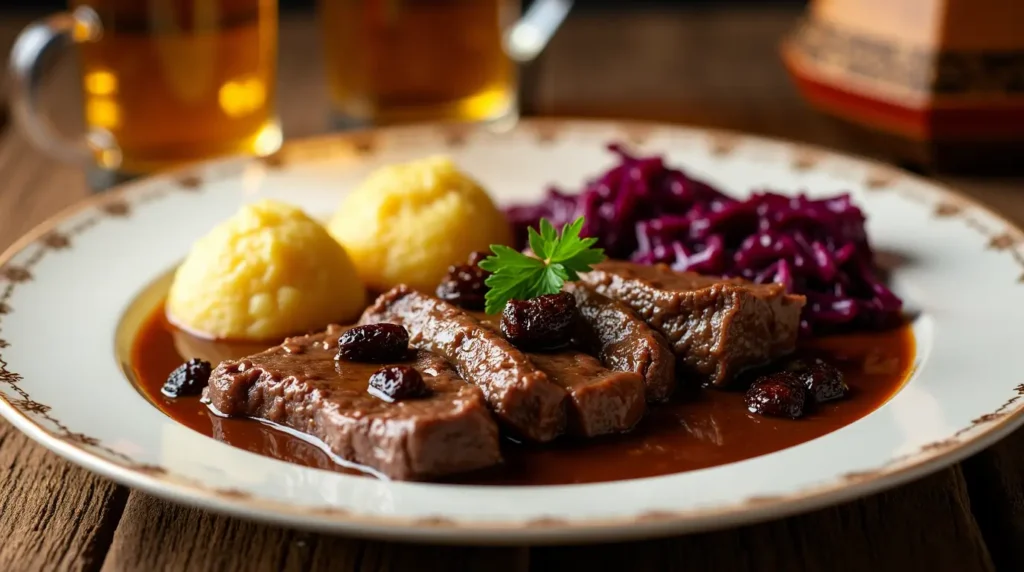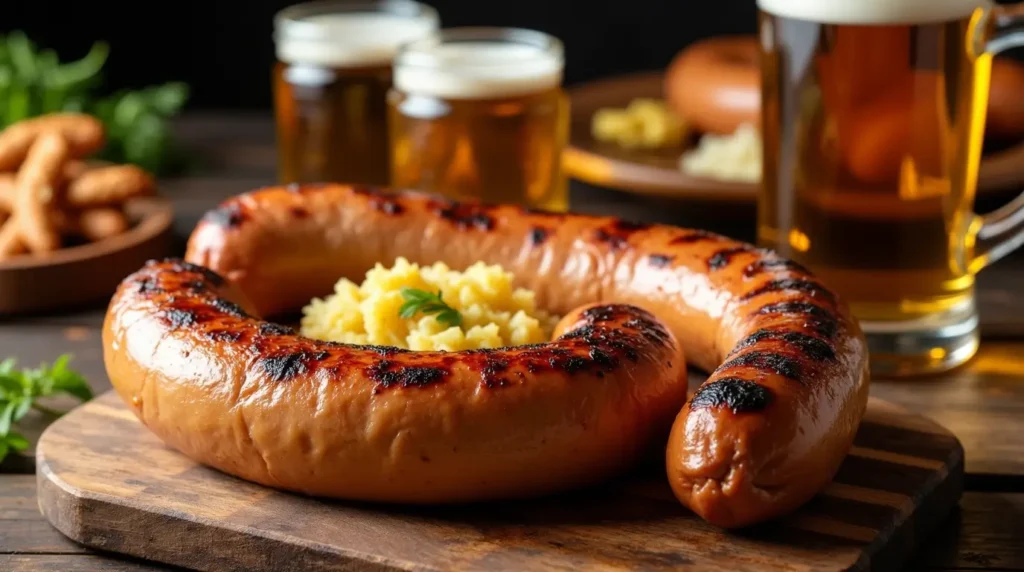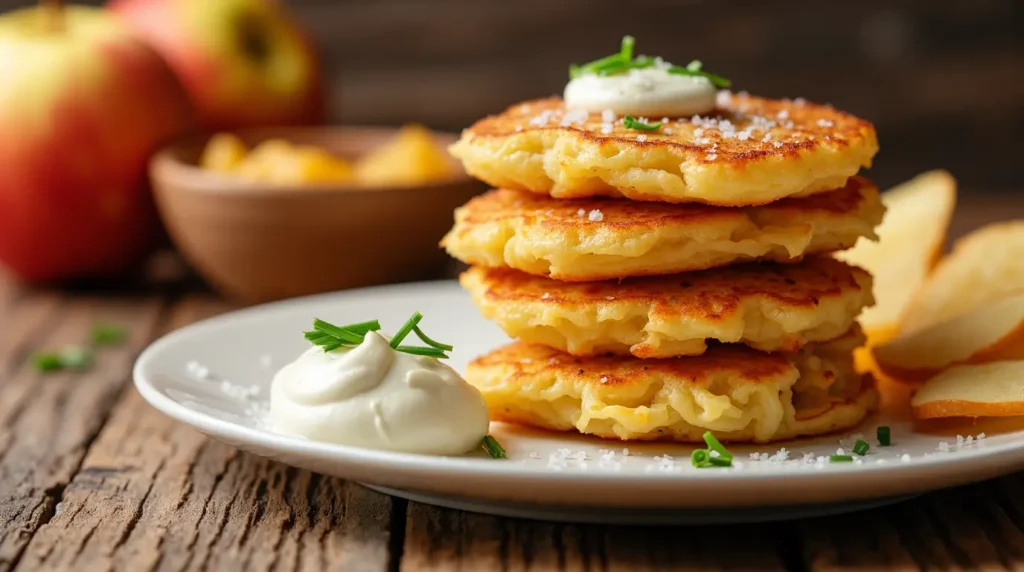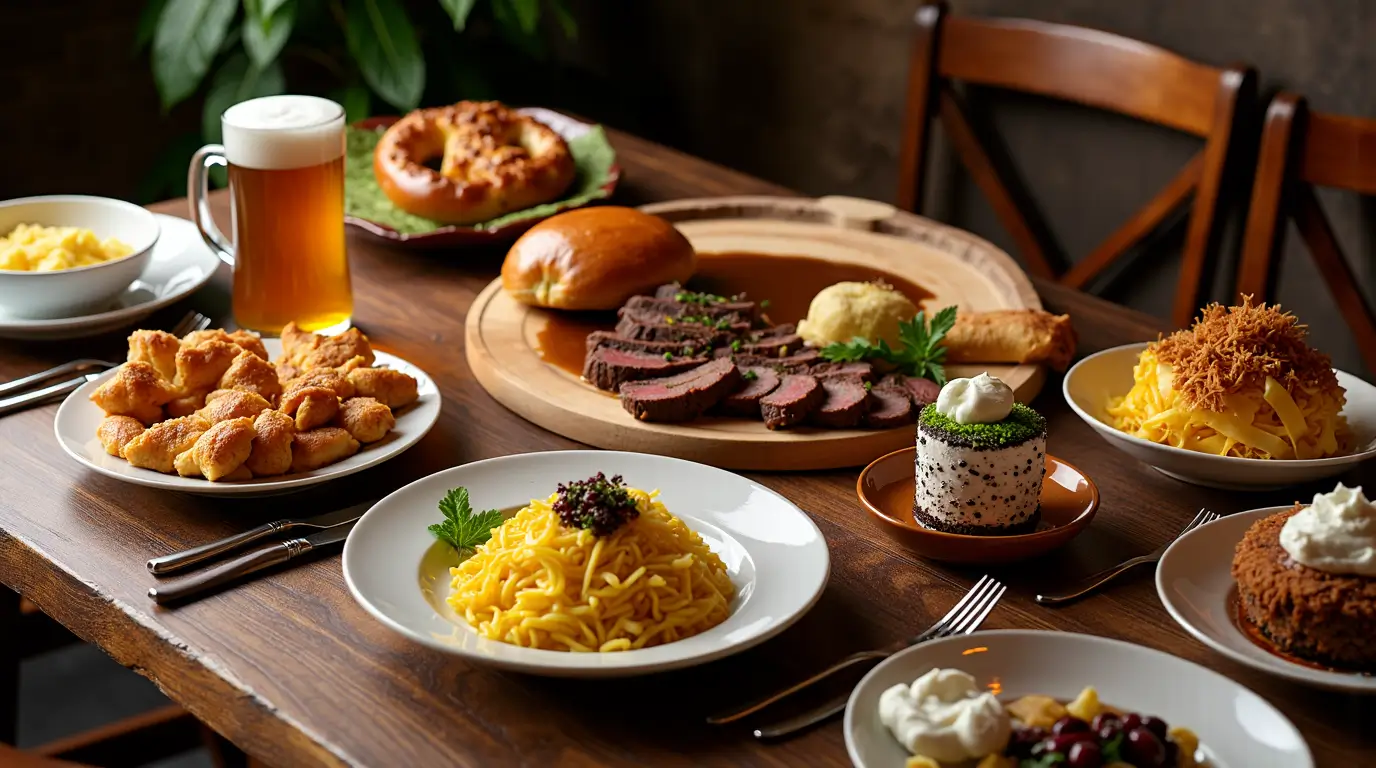Table of Contents
Table of Contents
Introduction
Germany, located in the heart of Europe, boasts a rich and diverse cuisine shaped by centuries of cultural exchange, historical influences, and regional adaptations. Famous globally for its sausages, pretzels, and beer, German cuisine goes far beyond these popular exports. Each region—from the North Sea coast to the Bavarian Alps—offers its own unique contributions to the nation’s gastronomy, showcasing an astounding variety of flavors, techniques, and local products.
In recent decades, Germany’s culinary scene has evolved significantly, embracing both tradition and innovation. Modern German chefs often reinterpret centuries-old recipes to create fresh, vibrant dishes that appeal to a contemporary global audience. At the same time, markets across the country remain a treasure trove of local ingredients, ensuring that time-honored favorites remain an intrinsic part of everyday life.
This article will explore the history, regional differences, must-try dishes, defining flavors, and table customs associated with German cuisine. It will also delve into modern trends, such as fusion cooking and the growing interest in sustainable farm-to-table practices. If you’ve been curious about Germany’s culinary landscape—beyond pretzels and beer—read on to discover why this gastronomic tradition is cherished by food enthusiasts around the world. By the end, you’ll not only have a deeper understanding of German food culture but also be inspired to try making some of these dishes in your own kitchen.
Culinary Context and History
A Brief Overview of Germany’s Culinary Evolution
German cuisine has developed over a long timeline, marked by migrations, trade routes, and political transformations. Historically, the territory that makes up modern-day Germany was a network of small principalities and kingdoms, each with its own resources, culinary traditions, and local customs. This fragmented political landscape inadvertently nurtured distinct regional cuisines that survive to this day.
In the Middle Ages, monasteries played an essential role in shaping German gastronomy. Monks and nuns were not only engaged in cultivating herbs and vegetables but were also experts in brewing beer, fermenting cheese, and developing early versions of pastries. Beer, in particular, found a special place in German society as both a staple beverage and a form of communal tradition. Even after centuries, Germany retains an impressive range of regional beers, from the hoppy Pilsner of the north to the rich Dunkel of Bavaria.
The Renaissance era and subsequent periods of trade expansion introduced new ingredients and cooking methods to Germany. Spices like pepper, nutmeg, and cinnamon—once considered luxuries—became more accessible, enriching both sweet and savory dishes. The influence of neighboring countries, such as France and Austria, also left a lasting imprint on German baking and pastry-making traditions.
Major Events and Key Periods
- Roman Influence (1st to 5th Century): Portions of present-day Germany were under Roman rule for centuries. This influence introduced viticulture—particularly in regions like the Moselle and Rhine—and also brought Mediterranean staples like olive oil, certain herbs, and wheat-based bread, although these were far from widespread at the time.
- Hanseatic League (13th to 17th Century): The Hanseatic League, a commercial and defensive confederation of merchant guilds, connected German port cities like Hamburg, Lübeck, and Bremen with trade centers across Northern Europe. This facilitated the flow of salted fish, Baltic herring, exotic spices, and other products into and out of Germany’s northern regions.
- Monastic Brewing (Middle Ages to Present): Brewing traditions honed in monasteries eventually turned Germany into one of the beer capitals of the world. The Reinheitsgebot (Beer Purity Law of 1516) is a notable legal tradition ensuring that only water, barley, and hops be used in the production of beer.
- Rise of Coffee Houses and Pastry Culture (18th Century): Influenced by Austria and France, coffee houses began to appear in Germany’s major cities, contributing to the country’s enthusiasm for cakes, tarts, and confections.
- Post-WWII Influence (Mid-20th Century): After the Second World War, Germany’s division into East and West led to distinct culinary evolutions. West Germany experienced an influx of international influences, especially from Italy and Turkey, introducing pizza, pasta, and döner kebab. Meanwhile, East Germany continued more traditional, resource-conscious cooking due to limited access to imported goods. The reunification of Germany brought these two culinary narratives together, enriching the modern food scene further.
Regional Differences in German Cuisine
- Northern Germany: Coastal regions such as Lower Saxony and Schleswig-Holstein incorporate a variety of fish and seafood, including herring, crab, and eel. Soups and stews are popular, reflecting the colder maritime climate. Smoked fish is also a local specialty.
- Western Germany: Influenced by neighboring France and the Benelux countries, the western regions (e.g., Rhineland-Palatinate) are known for their wine culture—particularly Rieslings—and for incorporating creamy sauces, fresh herbs, and lighter seasonings in dishes. Pork dishes and game meats (venison, boar) are also prevalent.
- Eastern Germany: This area includes Saxony, Thuringia, and Brandenburg. Strong culinary traditions like Thuringian sausages (Thüringer Rostbratwurst) are iconic. Potato dumplings (Kartoffelklöße) and hearty stews are staples. Historically, resourcefulness led to cooking methods that made the most of available ingredients, especially root vegetables and preserved meats.
- Southern Germany: Bavaria, Baden-Württemberg, and Swabia are rich in comfort foods—from pretzels and Weißwurst to hearty dumplings and rich gravies. Dairy and cheese feature prominently, thanks to abundant cattle farming in the Alpine regions. Bavaria’s beer culture is internationally famed, showcased by yearly celebrations like Oktoberfest.
These regional differences highlight how geography, trade, and cultural exchanges have culminated in a gastronomic tapestry that is uniquely German yet marvelously varied.
Key Ingredients and Local Products
Emblematic Foods and Their Importance
- Grains: Rye, wheat, and barley form the backbone of German baking and brewing. German bread culture is renowned worldwide, with hundreds of varieties, from dark and dense rye breads to crusty wheat rolls.
- Meats and Sausages: Pork is the most widely consumed meat, finding its way into countless sausage varieties—Bratwurst, Currywurst, Weisswurst, Mettwurst, and more. Beef and poultry also feature prominently, while game meats like venison and wild boar appear in more rural or festive dishes.
- Fish and Seafood: Northern regions lean heavily on fish, including herring (often pickled), carp, and pike. Smoked fish is a specialty of the coastal areas.
- Vegetables and Fruits: Potatoes are almost synonymous with German cuisine, appearing in salads, dumplings, pancakes, and side dishes. Cabbage (white, red, and savoy) is also a staple, used in making sauerkraut and other hearty preparations. Apples, plums, and berries are popular fruits, often baked into cakes or used in desserts and preserves.
- Dairy: Milk, butter, and cream are widely used, particularly in southern regions. Cheese-making traditions vary by region, with Bavaria and Allgäu producing notable varieties of mountain cheeses.
- Herbs and Spices: While German cuisine is not typically spicy in the chili-pepper sense, it is rich in aromatic herbs and spices. Caraway seeds, parsley, chives, dill, and juniper berries are common. Sweet spices such as cinnamon, cardamom, and cloves feature in breads, desserts, and festive pastries.
Seasonality and Its Impact on Traditional Dishes
Germany experiences four distinct seasons, which significantly influence culinary traditions:
- Spring: Marks the beginning of white asparagus (Spargel) season, a beloved national obsession. Many restaurants and home cooks prepare an array of asparagus-focused dishes, often served with Hollandaise sauce or melted butter.
- Summer: Warm weather ushers in fresh salads, grilled sausages at beer gardens, and fruit-based desserts featuring cherries, strawberries, and raspberries.
- Autumn: Harvest season yields pumpkins, mushrooms, and apples. Oktoberfest and regional wine festivals take center stage, with seasonal brews and Federweißer (young wine) accompanying hearty fare.
- Winter: Comfort foods dominate: stews, roasts, and baked goods like Stollen (fruit bread) and Lebkuchen (spiced gingerbread). Christmas markets across the country showcase mulled wine (Glühwein), roasted nuts, and seasonal confections.
Tips on Purchasing Ingredients
For those looking to recreate German dishes at home:
- Local Markets: Seek out farmers’ markets or specialized European grocery stores for fresh produce, artisanal bread, and unique German cheeses.
- Specialty Stores and Delis: Look for shops specializing in imported European products. These often carry German sausages, pickled fish, mustards, and baking ingredients (like specialty flours).
- Online Retailers: If you don’t have a local resource, online stores that specialize in European or German foods can provide sausages, spice blends, and unique sweets.
Being mindful of seasonality—especially when it comes to produce like white asparagus—can help recreate the authentic taste of German home cooking. Wherever possible, focus on quality, local, and sustainably sourced ingredients for the best results.
Must-Try Traditional Dishes
Germany’s culinary landscape is replete with iconic dishes that cater to various tastes. Below are some standout examples:
Sauerbraten

History and Characteristics:
Sauerbraten, a type of pot roast, holds a storied place in German cuisine. Legends attribute its origins to medieval times, when marinating meats in vinegar and spices was a practical method to preserve them. Today, Sauerbraten is often prepared with beef, though regional variations use venison or even horsemeat. The unique tart flavor from vinegar or wine, combined with sweeteners like sugar beet syrup or raisins, creates a sweet-and-sour profile that is uniquely German.
Key Ingredients:
- Beef roast (around 2 pounds)
- Vinegar and/or red wine
- Onions, carrots, celery (for the marinade)
- Spices: juniper berries, bay leaves, cloves, peppercorns
- Sweetener: sugar, raisins, or beet syrup
Serving Suggestions:
Typically served with red cabbage (Rotkohl) and potato dumplings (Kartoffelklöße), Sauerbraten exemplifies the hearty, comforting side of German cuisine.
Simplified Recipe (Short Version):
- Marinate: Place the beef roast in a mixture of vinegar, red wine, chopped onions, and spices. Refrigerate for at least two days.
- Brown and Simmer: Remove the meat, pat it dry, and brown on all sides. Strain the marinade, then add it to the pot along with some beef stock. Simmer until tender (about 2–3 hours).
- Finish the Sauce: Remove the meat, stir in a sweetener (raisins or beet syrup), and thicken the sauce with cornstarch or crumbled ginger snaps. Serve with red cabbage and dumplings.
Bratwurst

History and Regional Variations:
Bratwurst is a broad term for German sausages typically made from pork, though beef or veal variants exist. Different regions have unique spice blends and sizes. The historically documented Thuringian Rostbratwurst, for instance, has a distinct seasoning, often featuring marjoram. Nürnberg (Nuremberg) also boasts its own famous bratwurst, smaller in size and usually grilled over beechwood.
Ingredients and Preparation:
- Ground pork (or a mix with veal/beef)
- Salt, pepper, majoram, nutmeg (seasonings vary)
- Natural casing
Bratwurst is most commonly grilled or pan-fried. It can be served in a bread roll (Brötchen) with mustard or accompanied by sauerkraut and potato salad for a heartier meal.
Schnitzel (and Its Variations)

Origins and Characteristics:
While the Wiener Schnitzel is originally associated with Austria, Germany has wholeheartedly embraced this dish, featuring pork (Schweineschnitzel) or chicken (Hähnchenschnitzel). The thinly pounded meat is coated in flour, egg, and breadcrumbs before being fried to a golden crisp.
Regional Twists:
- Jägerschnitzel (Hunter’s Schnitzel): Served with a mushroom cream sauce.
- Zigeunerschnitzel (Gypsy Schnitzel): Accompanied by a bell pepper, onion, and tomato-based sauce.
- Rahmschnitzel (Cream Schnitzel): Enveloped in a rich cream sauce.
Kartoffelpuffer (Potato Pancakes)

Popularity Across Regions:
Potato pancakes, known as Reibekuchen in the Rhineland or Kartoffelpuffer in many other regions, are a crisp, golden treat. They can be served sweet—accompanied by applesauce—or savory, paired with smoked salmon or sour cream.
Simple Tips for Making Potato Pancakes at Home:
- Grate peeled potatoes and mix with grated onion.
- Squeeze out excess moisture.
- Combine with eggs, a little flour, salt, and pepper.
- Fry spoonfuls in hot oil until golden. Serve immediately.
Defining Characteristics of German Cuisine
Taste Profile: Balanced and Hearty
German cuisine is often associated with robust, hearty flavors rather than intense heat or spiciness. The primary seasonings—salt, pepper, caraway, juniper—lend complexity without overwhelming the palate. Sweet-and-sour contrasts are common, as seen in dishes like Sauerbraten or red cabbage braised with apples and vinegar.
Representative Seasonings and Flavor Combinations
- Caraway and Cabbage: Used in many breads and cabbage-based dishes, giving a distinctive aroma.
- Juniper Berries and Game Meats: Lending an earthy, piney note to roasts and stews.
- Mustard: Spanning mild to spicy, it’s an essential condiment for sausages and pretzels.
- Sweet Spices (Cinnamon, Cloves, Cardamom): Found in baked goods, Christmas pastries, and even some savory sauces.
Appeal to Food Enthusiasts
The warmth and comforting nature of German dishes resonate with those seeking hearty, satisfying meals. The attention to artisanal bread, sausages, and seasonal ingredients also appeals to gastronomes who appreciate craft production and local sourcing. Food lovers intrigued by layers of historical and regional variation will find German cuisine endlessly fascinating.
Tips and Highlights to Encourage People to Try German Cuisine
- Cultural and Gastronomic Heritage: Germany’s long brewing tradition, celebrated bread culture, and artisanal cheese-making practices offer a holistic culinary experience.
- Festivals and Markets: Visiting Germany during Oktoberfest or Christmas markets can be a gateway to discovering authentic fare like roasted nuts, mulled wine, and specialty sausages.
- Regional Specialties: Sampling distinct regional dishes (e.g., smoked fish in the north, pretzels in Bavaria) provides a flavorful journey across the country.
- Anecdotes and Personal Stories: Many German families have recipes passed down through generations. Sharing these dishes at gatherings often involves stories of family heritage, local customs, and cherished memories.
By focusing on these cultural and culinary highlights, newcomers to German cuisine can gain a deeper appreciation of what makes these dishes truly special.
Table Rituals and Customs
Typical Meal Structure in Germany
- Breakfast (Frühstück): Often a hearty affair with a selection of breads, rolls, cold cuts, cheeses, jams, and boiled eggs. A cup of coffee or tea complements the meal.
- Lunch (Mittagessen): Traditionally the main meal of the day, although modern lifestyles may have shifted this to dinner for many. A typical lunch could include a soup or salad starter, followed by a main dish of meat or fish with vegetables and potatoes.
- Afternoon Coffee and Cake (Kaffeetrinken): A beloved tradition, this break involves enjoying a slice of cake or pastry (Kuchen) with a warm beverage.
- Dinner (Abendessen or Abendbrot): Historically lighter, featuring bread, cold cuts, cheese, and pickles. However, many families now have their main hot meal in the evening due to work schedules.
Table Etiquette and Local Customs
- Knife and Fork Placement: Germans typically keep their fork in the left hand and knife in the right hand while dining.
- No Elbows on the Table: It’s considered impolite to rest your elbows on the table.
- “Guten Appetit!”: Before starting a meal, it’s common to wish everyone a hearty “Guten Appetit!” (meaning “Enjoy your meal!”).
- Clinking Glasses: When toasting with friends, make eye contact to show respect.
- Finishing Your Plate: While you are not strictly required to finish every morsel, leaving a significant amount of food on your plate might be taken as a sign that the meal was less than satisfactory.
Holidays, Religious Events, and Family Celebrations
- Christmas (Weihnachten): Central to German holiday cuisine. Specialties include roasted goose or duck, Stollen (fruit loaf), Lebkuchen (spiced cookies), and Glühwein. Many families bake Christmas cookies (Plätzchen) to share with guests.
- Easter (Ostern): Easter brunches often feature a decorated table with painted eggs, fresh breads, and lamb or ham. Bakeries sell special Easter breads and cakes.
- Oktoberfest (Bavaria): The world’s largest beer festival in Munich. Giant pretzels, roast chicken (Hendl), pork knuckles (Schweinshaxe), and of course, beer served in large steins are iconic.
- Carnival/Fasching/Fastnacht: Different regions celebrate with doughnuts (Krapfen, Berliner, Pfannkuchen) and other sweet treats before the start of Lent.
Each celebration showcases the country’s strong cultural ties between food and festivity, reflecting both local and national traditions.
Modern Trends and Culinary Fusions
Evolving Through International Influences
German cuisine continues to evolve as it encounters global gastronomies. International restaurants and immigrants have brought a variety of tastes to Germany:
- Italian Influence: Pizza, pasta, and espresso culture are deeply embedded, particularly in big cities.
- Turkish Influence: The döner kebab, introduced by Turkish immigrants, is now a ubiquitous street food across Germany.
- Pan-Asian Cuisines: An array of Chinese, Vietnamese, Thai, and Japanese restaurants have sprouted up, introducing new flavors and techniques.
Many contemporary German chefs incorporate these global tastes into traditional dishes, creating a fusion that respects heritage while welcoming innovation.
New Consumption Trends
- Vegetarian and Vegan Options: Driven by a rise in health consciousness and sustainability concerns, more German restaurants now offer vegetarian and vegan versions of classic dishes, such as vegan sausages or plant-based Schnitzel alternatives.
- Farm-to-Table Movement: A growing emphasis on locally sourced, organic produce has revived small-scale farming. Farmers’ markets and organic supermarkets (Bio-Supermärkte) are increasingly popular, reflecting a societal shift toward sustainable consumption.
- Craft Beer Renaissance: While Germany has always been a beer powerhouse, the recent global craft beer trend has seen microbreweries experimenting with IPAs, stouts, and flavored beers, adding to the already abundant beer culture.
Young Chefs and Restaurateurs Reimagining Traditional Fare
Across Germany, a new generation of chefs is injecting creative flair into time-honored recipes:
- Creative Plating: Traditional dishes like Königsberger Klopse (meatballs in a white caper sauce) might be deconstructed or garnished with microgreens and colorful sauces.
- Fine-Dining Spins on Comfort Food: Berlin, Hamburg, and Munich host Michelin-starred establishments where braised pork belly, dumplings, or smoked fish are served in elegant, minimalist presentations.
- Emphasis on Regional Quality: These chefs often highlight local producers, forging partnerships that guarantee high-quality ingredients while maintaining a sense of place.
This wave of culinary innovation keeps German cuisine dynamic, ensuring a constant conversation between tradition and modernity.
Conclusion and Call to Action
German cuisine, with its deep historical roots and regional distinctions, offers a vast and varied feast for the senses. From the savory comfort of slow-cooked Sauerbraten to the crisp delight of Bratwurst fresh off the grill, Germany’s gastronomic traditions shine through in every dish. The love of bread and beer underscores a national commitment to craft and quality, while the importance of seasonal ingredients highlights an age-old respect for the rhythms of nature.
Key Points Recap:
- Rich History and Regional Diversity: Germany’s past—from medieval monastic brewing to Hanseatic trade and foreign influences—has led to distinct culinary customs in each region.
- Staple Ingredients and Products: Bread, sausages, potatoes, cabbage, and dairy form the cornerstones of German cooking, enriched by herbs, spices, and seasonal produce.
- Must-Try Dishes: Sauerbraten, various Bratwurst styles, Schnitzels, and potato specialties illustrate Germany’s hearty yet balanced flavor profile.
- Table Customs: Structured mealtimes, “Guten Appetit,” and traditions like afternoon coffee and cake shape the dining experience.
- Modern Innovations: The fusion of international flavors, a rise in vegetarianism, and young chefs reimagining classics keep German cuisine evolving.
Invitation to Experience German Cuisine:
Whether you’re planning a trip to Germany or exploring new recipes in your kitchen, delve into the breadth of German culinary tradition. Start by sourcing authentic German sausages or trying your hand at baking a loaf of crusty rye bread. Invite friends and family to a German-themed dinner—complete with pretzels, mustards, and regional beer—and share in the communal joy that food can bring.
We would love to hear about your experiences experimenting with German recipes, sampling sausages from specialty stores, or attending an Oktoberfest celebration. Share your stories, favorite recipes, or any questions you have about Germany’s vibrant gastronomic heritage. In a future article, we might dive deeper into the world of German bread culture—covering everything from rye sourdough starters to intricate braided bread traditions—so stay tuned for more insights into this fascinating culinary realm.
Germany’s culinary story continues to unfold, blending centuries of tradition with fresh perspectives. Let your taste buds guide you through this journey—and don’t forget to say “Prost!” (cheers) the next time you raise a glass of your favorite German beer. Bon appétit, or rather, Guten Appetit!

